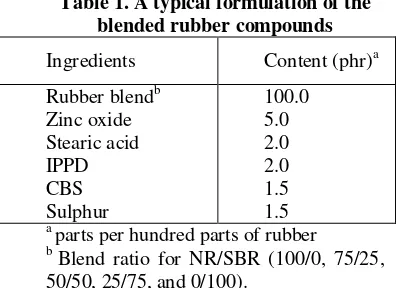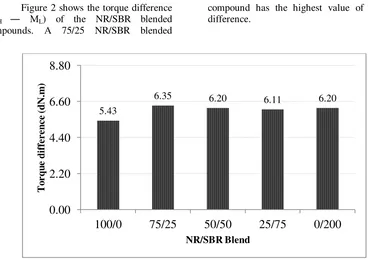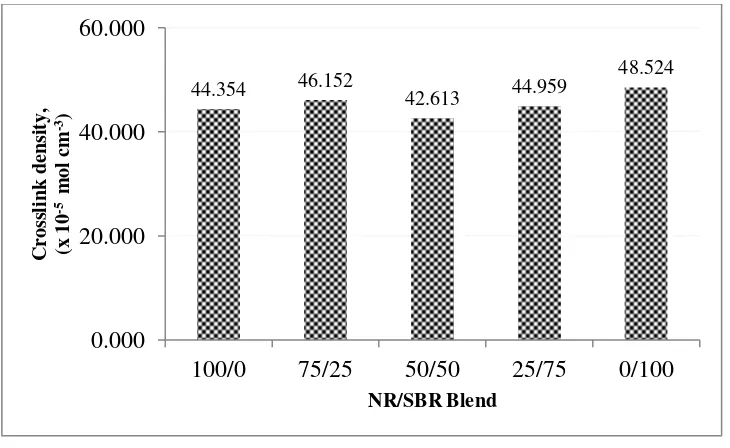CURE CHARACTERISTICS AND CROSSLINK DENSITY OF NATURAL
RUBBER/STYRENE BUTADIENE RUBBER BLENDS
Indra Surya, Syahrul Fauzi Siregar
Department of Chemical Engineering, Engineering Faculty, University of Sumatera Utara, Medan 20155, Sumatera Utara, Indonesia
E-mail: [email protected]
Abstract
By using a semi-efficient vulcanization system, the cure characteristics and crosslink density of natural rubber/styrene butadiene rubber (NR/SBR) blends were studied with a blend ratio from 0 to 100% rubber. The scorch time, optimum cure time, and torque difference value of the blended rubber compounds were determined by using the Moving-Die Rheometer (MDR 2000). The crosslink density was determined by the Flory—Rehner approach. Results indicate that the scorch and cure times, ts2 and t90, of the NR/SBR blends
increased with increasing the SBR content. Whilst, the maximum values of torque difference and crosslink density were performed by the NR/SBR blend with a blend ratio of 75/25.
Keywords : Natural Rubber; Styrene Butadiene Rubber; Scorch time; Cure time; Torque difference, Crosslink density.
Abstrak :
Dengan menggunakan sistim vulkanisasi semi-effisien, karakteristik pematangan dan kerapatan sambung silang dari kompon adonan-adonan Karet Alam/Karet Stirena Butadiena (KA/KSB) diamati. Rasio adonan adalah dari 0% ke 100% karet. Waktu skorj, waktu pematangan optimum, dan selisih tork dari adonan-adonan karet tersebut ditentukan dengan menggunakan Moving-Die Rheometer (MDR 2000). Kerapatan sambung silang diukur dengan menggunakan metode Flory - Rehner. Hasil pengamatan menunjukkan bahwa waktu skorj dan waktu pematangan optimum, ts2 and t90, meningkat dengan meningkatkan komposisi KSN di dalam adonan karet-karet tersebut. Nilai-nilai selisih tork dan kerapatan sambung silang yang maksimum diperoleh oleh adonan KA/KSB dengan rasio adonan 75/25.
Kata kunci : Karet Alam; Karet Stirena Butadiena; Waktu skorj; Waktu pematangan optimum; Kerapatan sambung silang.
Introduction
In rubber technology, blending of some raw rubbers is an attempt to produce some new rubbery materials with a wide range of applications. The attempt takes some advantages of the attractive properties of the blend constituents while avoiding the economical and technical uncertainties associated with synthesising new rubbery materials [6,13]. The blending of two or more raw rubbers of different types is useful for the preparation of materials with properties absent in the rubber components [9,11,14]. Natural rubber (NR) and its blended compounds have been extensively studied because of their superior performance in a wide range of applications, especially in tire application. Natural rubber is prone to deterioration by ozone attack due to its highly unsaturated polymeric backbone. In general, improvement in the poor ozone resistance of NR can be achieved by blending it with low-unsaturation rubbers such as styrene butadiene rubber (SBR). SBR is obtained by polymerising
styrene and butadiene with a relatively small amount of a non-conjugated diene, which usually imparts good resistance to aging, weathering and chemical resistance [1,3,6].
In this study, NR was blended with SBR with some of blend ratios. The cure characteristics and crosslink density of blended NR/SBR compounds were studied. Cure characteristics of the blended rubber compounds were determined by using a Moving Die Rheometer which cured at 150 oC, with, and the crosslink density was measured by the Flory—Rehner approach.
Experimental Materials
Compounding
A semi efficient vulcanization system was used for compounding. The recipe for the preparation of the NR/SBR blended
Table 1. A typical formulation of the blended rubber compounds
Ingredients Content (phr)a
Rubber blendb
parts per hundred parts of rubber b
Blend ratio for NR/SBR (100/0, 75/25, 50/50, 25/75, and 0/100).
Cure Characteristics difference (MH—ML), according to ISO 3417. Samples of the respective compounds were tested at 150oC. The compounds were subsequently compression-moulded using a stainless steel mould at 150oC, with a pressure of 10 MPa, and applying a laboratory hot-press based on respective curing times.
Measurement of crosslink density
Swelling tests on the rubber vulcanisates were performed in toluene in accordance with ISO 1817. The cured test pieces (30 mm × 5 mm × 2 mm) were weighed using an electrical balance and swollen in toluene until equilibrium, which took 72 hours at room temperature. The samples were taken out from the liquid, the toluene was removed from the sample surfaces and the weight was determined. The samples were then dried in
the oven at 60oC until constant weights were obtained. The swelling results were used to calculate the molecular weight between two crosslinks (Mc) by applying the Flory-Rehner parameter of the rubber network-solvent (χ of NR = 0.393). The degree of the crosslink density is given by;
c
The cure characterisics
Figure 1. Scorch and cure times of NR/SBR blended compound
Figure 2 shows the torque difference (MH ― ML) of the NR/SBR blended compounds. A 75/25 NR/SBR blended
compound has the highest value of torque difference.
Figure 2. Torque difference of NR/SBR blended compound
The crosslink density
The crosslink densities of the vulcanisates NR/SBR blend were determined by the Flory—Rehner approach [Eq. (1)]. Figure 3 shows the crosslink density of the rubber blended vulcanisates at room temperature. The 75/25 NR/SBR blended rubber compound has the highest degree of crosslink. It can be attributed to the synergetic effect of both raw rubbers, NR and SBR. This
result is in line with Figure 2. The 75/25 NR/SBR blended rubber compound exhibited the highest value of torque difference. Based on theory, torque difference indicates the degree of crosslink density of a rubber compound [2,4,5,10]. The greater the value, the higher is the crosslink density.
2.85 3.47
4.40 5.90
6.58 5.58 6.98
8.83
11.12 12.09
0.00
5.00
10.00
15.00
100/0
75/25
50/50
25/75
0/100
Ti
m
e
(m
in
.)
NR/SBR Blend
ts2
t90
5.43
6.35 6.20 6.11 6.20
0.00
2.20
4.40
6.60
8.80
100/0
75/25
50/50
25/75
0/200
To
r
q
u
e
d
iffe
r
e
n
c
e
(d
N
.m
)
Figure 3. Crosslink density of NR/SBR blended vulcanisate
Conclusions
From this study, the following conclusions can be drawn:
1. The scorch and cure times of natural rubber/styrene butadiene blended compound increase with increasing the content of styrene butadiene rubber. 2. A 75/25 blend ratio is the optimum blend
ratio of natural rubber/styrene butadiene rubber blend which produced the maximum values of torque difference and crosslink density.
Acknowledgements
The authors would like to thank Directorate General of Higher Education Ministry of Education and Culture of Republic Indonesia for Research Grant, under Penelitian Hibah Bersaing scheme, with Contract No. 4804/UN5.1.R/KEU/2014.
References
[1] A. Kumar, G. Dipak, K. Basu, Natural rubber–ethylene propylene diene rubber covulcanization: Effect of reinforcing fillers, J. Appl. Polym. Sci. 84 (2002) 1001-1010.
[2] B. Boonstra, H. Cochrane, E. Dannenberg, Reinforcement of silicone rubber by particulate silica, Rubber Chemistry and Technology, 48 (1975) 558-576.
[3] F. Delor-Jestin, J. Lacoste, N.
Barrois-Influence of carbon black, crosslinking and stabilizing agents, Poly. Degrad. Stab. 67 (2000) 469-477.
[4] H. Cochrane, C. Lin, The influence of fumed silica properties on the processing, curing, and reinforcement properties of silicone rubber, Rubber Chemistry and Technology, 66 (1993) 48-60.
[5] H. Ismail, C. Ng, Palm oil fatty acid additives (POFA's): Preparation and application, Journal of Elastomers and Plastics, 30 (1998) 308-327.
[6] H. Nabil, H. Ismail, A. Azura, Compounding, mechanical and morphological properties of carbon-black-filled natural rubber/recycled ethylene-propylene-diene-monomer (NR/R-EPDM) blends, Polymer Testing, 32 (2013) 385-393.
[7] H. Ismail, S. Shaari, N. Othman, The effect of chitosan loading on the curing characteristics, mechanical and morphological properties of chitosan-filled natural rubber (NR), epoxidised natural rubber (ENR) and styrene-butadiene rubber (SBR) compounds, Polymer Testing, 30 (2011) 784-790. [8] P.J. Flory, J. Rehner Jr., Statistical
mechanics of crosslinked polymer networks II. Swelling, J. Chem. Phys., 11 (1943) 521.
epoxidized natural rubber as a compatibilizer in melt compounded natural rubber–organoclay nanocomposites, European Polymer Journal, 40 (2004) 2513-2521.
[11] S. H. El-Sabbagh, Compatibility study of natural rubber and ethylene-propylene-diene rubber blends, J. Appl. Polym. Science. 90 (2003) 1-11.
[12] S.H. Chough, D.H. Chang, Kinetics of sulfur vulcanization of NR, BR, SBR, and their blends using a rheometer and DSC, Journal of Applied Polymer Science, 61 (1996) 449-454.
[13] W. Arayapranee, G. Rempel, Properties of NR/EPDM blends with or without methyl methacrylate-butadiene-styrene (MBS) as a compatibilizer, Intern. J. Mater. Struc. Relia. 5 (2007) 1-12. [14] Y.W. Chang, Y.S. Shin, H. Chun, C. Nah,


